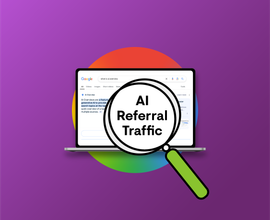Scaling Enterprise SEO: Navigating Unique Challenges for Maximum Impact
Enterprise SEO—quite literally—refers to SEO that happens at an enterprise-sized company.
Scaling enterprise SEO refers to the ability to increase SEO efficiency and maximize impact related to core business objectives.
To do enterprise SEO right, you need to scale effectively. The following 8 enterprise SEO challenges are the most common hurdles to scaling and maximizing impact:
- Lack of speed
- Soft skills development
- Lack of resources + internal roadblocks to securing buy-in
- Centralized vs. decentralized SEO and SEO governance
- Focusing on the wrong SEO efforts
- Historical enterprise SEO neglect
- Ineffective use of SEO data or solutions
- Unable to procure the best SEO solution
Enterprise SEO produces unique challenges for SEOs and digital marketers to overcome for maximum impact.
The slower decision-making processes at the enterprise level, organizational silos, historical enterprise SEO neglect, and a lack of understanding from stakeholders on the importance of SEO can dismantle even the most seasoned search expert’s efforts. SEOs and channel owners need to rethink their approach and identify adaptive solutions to overcome the most common enterprise SEO challenges and ensure their initiatives deliver the highest ROI possible.
What is the difference between regular SEO and enterprise SEO?
In the simplest terms, the main difference between regular SEO and enterprise SEO is that enterprise SEO happens at enterprise-sized businesses. Enterprise SEO is specific to navigating a large organization and achieving good SEO results.
As a result, you’re not reporting to the CEO or founders like you might at an SMB. Instead, you report to leaders a few layers down, which leads to slower decision-making and approvals, more red tape, organizational silos, and other specific enterprise SEO challenges for search experts and marketing leaders to overcome.
What is scale in SEO?
When we talk about scale in SEO or scalable enterprise SEO, we’re referring to the ability to increase SEO efficiency and maximize impact related to core business objectives.
Achieving success in enterprise SEO comes down to one core question: are you able to assess, prioritize, and implement SEO initiatives at the scale necessary for expansive sites? Today’s SEO experts have the knowledge to do so but face SEO challenges specific to enterprise-sized organizations that require another set of skills and solutions to overcome.
How to scale enterprise SEO: Top challenges and solutions
Consider us your enterprise SEO partner. Whether you’re facing extensive legacy enterprise SEO mistakes or struggling to get your next ROI-driving initiative approved, we have the answers.
Here are the top eight enterprise SEO challenges our customers face most often. Download the complete guide to access the action-oriented solutions to these challenges sourced from our SEO experts.
1. Lack of speed
Enterprise organizations are notorious for their slow internal processes, arguably their biggest weakness. At some enterprise companies, getting budget approvals, securing the necessary cross-departmental support, or getting all stakeholders to sign off on a new website optimization project can take weeks (or even months).
Effective enterprise SEO requires speed. You’ll never hit your marketing KPIs if your SEO experts have to wait six to nine months to implement recommendations due to internal red tape and a lack of prioritization from the executive level.
One thing we’ve seen time and time again with our customers is the constant deprioritization of SEO due to department heads and execs not understanding the importance of SEO. Initiatives will continue to be deprioritized when there is a lack of understanding of the why behind the project.
This challenge is compounded at global enterprise companies when the implementation team is based in a different country or region than the marketing or SEO departments, yet this team owns all website edits. The back-end tech experts have wide-ranging (and competing) priorities, tend to manage updates across multiple regions, and are always strapped for time. As a result, they often deprioritize SEO implementation asks or implement them incorrectly because they don’t understand the why behind the need.
How to solve:
To minimize the lack of speed with SEO implementations, which is common due to bureaucracy or lack of buy-in in enterprise environments, you must align your SEO action plan with existing marketing and product efforts and priorities.
Doing so ensures your activities are not seen as competing with others from marketing, products, or UX, but rather as an additional reason to focus on what already matters to many other stakeholders and decision-makers, facilitating faster implementation of your SEO tasks.
Steal a page from the Agile software development playbook:
- Spend more time explaining the why than the what
- Always talk about the business value
- Cut your big idea into small increments
For example:
Don't say you want to optimize title tags. Talk about generating an additional $800,000 (annualized) in revenue without incremental cost by optimizing title tags.
Don't start with a headless CMS operated by the SEO team with built-in SEO A/B testing capabilities. Start collaborating with the content department to optimize title tags for 100 important landing pages.”
Explore additional action-oriented solutions to this enterprise SEO challenge, along with the other challenges listed below, by completing the form and downloading the comprehensive guide.
2. Soft skills development
Getting something done in enterprise SEO often relies on soft skills , so much so that soft skills might even be more important than SEO skills and competency. Digital leaders and SEO channel owners spend more time identifying the best way to report on results, present insights to executives, and manage up than they do on technical implementation.
How to solve:
Knowing how to communicate, influence, and coordinate your SEO activities across different areas by tying your SEO activities and goals to business ones is fundamental as an enterprise SEO specialist.
From there, developing your project management and soft skills is critical, like further refining how to communicate results to technical and non-technical stakeholders and decision-makers.
3. Lack of resources compounded by internal roadblocks to secure buy-in
Another major enterprise SEO mistake happens when the necessary resources are not provided or invested in. Some marketing teams at enterprise organizations only have one or two individuals owning the entire SEO strategy. Others may have a built-out team, including SEO generalists, technical SEOs, and an organic channel owner, but overlook the importance of hiring full-time content writers. The rise of AI has made some enterprise organizations think content or copywriters are optional and that AI-generated content produces all the writing they’ll need. (Spoiler: it doesn’t.)
Then there’s the SEO vs. PPC comparison. PPC teams have an easier time securing budget because they can easily show the ROI of their efforts, thanks to tools and platforms with comprehensive reporting. Execs want to see the same type of provable ROI from SEO before investing. But SEO is not PPC. And the only way to provide those metrics is with an enterprise SEO solution and a fully realized team of SEO specialists.
In turn, limited resource allocation intensifies internal roadblocks to secure buy-in on SEO from the top down. The SEO solution your budget allows for might not provide the right data and ROI metrics your execs need to understand the bigger picture. When strapped for time and resources, search experts can get lost in the black box of data and metrics that make sense to them but are lost on their executive audience.
It becomes a self-fulfilling prophecy. Those limited resources mean you don’t have time to provide pivotal education and effective reporting to get decision-makers on board with increased SEO investments, meaning the buy-in (and the corresponding resources) never comes.
How to solve:
Provide value upfront. Engage with other marketing leaders within your organization to obtain buy-in by elevating valuable data and insights from your SEO reporting & analysis that can benefit other channels.
Example: Sharing insights with your Paid or Demand team around opportunities to decrease spend for terms where you already own the SERP organically can help start the conversation on other ways SEO can support the entire marketing department.
Consider that a teaser of the detailed guidance and solutions provided in the downloadable guide. Access the complete list of enterprise SEO solution recommendations from Ryan and fellow SEO experts by filling out the form to the right and reading the guide.
4. Centralized vs. decentralized SEO and SEO governance
Centralized SEO is where one central team owns all strategic decision-making and operates as the channel owner. Decentralized SEO is when multiple teams or different brands that own SEO operate in silos with limited to no collaboration between these groups.
How can you accomplish SEO objectives when the individuals executing it are a part of a central team of leaders far removed from the day-to-day implementation or are split across various groups? This becomes much harder to overcome when teams are split across countries and time zones.
Centralized vs. decentralized internal SEO structures also highlight the importance of developing an SEO governance strategy to safeguard your SEO performance. Governance strategies can get overlooked in enterprise organizations for different reasons. SEOs can start off on smaller teams where responsibilities and oversight are clear without needing documentation. But when teams expand or are split across regions or countries, those governance policies protect current rankingsRankings
Rankings in SEO refers to a website’s position in the search engine results page.
Learn more, website performance, and user experienceUser Experience
User experience (or UX for short) is a term used to describe the experience a user has with a product.
Learn more.
5. Focusing on the wrong SEO efforts
You could have all the resources you could hope for—expansive budget, preferred SEO solution, ideal team structure—but it won’t make a difference if your organization focuses on the wrong SEO priorities. Many marketers make the common enterprise SEO mistake of prioritizing overexpansion of net new content creation over strategic optimizations to top revenue-driving website pages.
Enterprise SEO excels when it’s fueled by data-driven insights and a strategic approach. A lot of the time, it’s SEO basics that drive the most value on enterprise websites. But marketers and execs can get lost prioritizing efforts because they are shiny and new vs. implementing what is proven to work.
How to solve:
Creating a prioritization framework can help centralized and decentralized teams deliver more value. This involves linking SEO action to business objectives and measuring the effects. This should help teams steer clear of activities that do not contribute to the success of the channel.
Focusing on efforts that do not generate a positive outcome can be a huge time sink and result in negative SEO ROI and performance over time.
6. Historical enterprise SEO neglect
You don’t know what you don’t know, and that statement has never been more true than when referring to the history of any enterprise SEO website.
Most enterprise companies have been around for at least a few years, if not decades. There is a treasure trove of any SEO’s worst nightmares hiding in that historical website data. From hidden website structureWebsite Structure
A website's structure refers to how the website is set up, i.e. how the individual subpages are linked to one another.
Learn more elements to one-off coding patches, hundreds of broken or outdated redirects, cannibalization of duplicate contentDuplicate Content
Duplicate content refers to several websites with the same or very similar content.
Learn more, and excruciatingly slow loading speeds, there is no getting around historical enterprise SEO neglect.
Maybe there was high turnover for a few years or a lack of SEO investments, so short-term solutions were the option. Regardless of how it got this way, it’s now on you to identify and resolve these issues to provide your website with the strongest possible foundation to improve rankings.
How to solve:
Prioritization is the most important skill to learn in enterprise SEO, especially when you have a lot of historical SEO neglect to deal with.
Learn to triage issues and consider using something like a JIRA board to catalog things that need fixing as you find them. But resist the urge to fix everything at once. Find the things that are actually driving traffic and fix those first while you build your backlog.
This may mean your website fails traditional SEO tools’ health tests while you address more pressing issues. Focus, focus, focus. Work on what will drive change and revenue, and let the rest lapse until you can come back to it later.
Do a thorough, in-depth SEO audit. It’s time-consuming, but implementing a comprehensive SEO audit is the only real path forward. You’ll want to audit your website content and the site’s technical health and structure. This will produce a list of the core issues to help you prioritize which to focus on first.
Historical SEO neglect is a challenge we encounter frequently with our clients. In some cases, the company never considered SEO when launching a website, which can lead to significant technical or discoverability issues.
In other cases, the client may have worked with less-than-trustworthy SEO consultants or companies in the past whose recommendations led the site to get into trouble with manual actions or algorithmic impacts.
Understanding as much information about the site’s history as it relates to SEO is necessary to do a good job going forward. This often requires digging through the data, as not every stakeholder will know exactly what happened with the site (or may not even want to share all the details).
Provide stakeholders with industry or competitive benchmarks. Sometimes numbers do more than words ever could. This is especially true when selling an exec on why you need several months to address pressing historical SEO issues before creating new content. Comparing your site to the latest industry or competitive benchmarks can paint a clear picture for decision-makers on why these fixes must be prioritized.
Suppose your industry’s average organic traffic benchmark is 30 points higher than your site. In that case, this competitor benchmark supports the argument that significant historical issues need to be resolved before website performance can get on par with competitors’ websites.
Find more in-depth solutions to this enterprise SEO challenge in our downloadable guide.
7. Ineffective use of SEO data or solutions
SEO data is notoriously difficult to access and compile. Depending on which SEO platforms or solutions they have access to, many SEOs and marketing leaders make the mistake of relying on the wrong metrics, misinterpreting data, or failing to maximize the functionality of the chosen solution.
Today, enterprise organizations know they have to invest in some type of enterprise SEO technology. But a majority still need to figure out what to do with it once they get it.
8. Unable to procure the best SEO solution
The enterprise tech procurement process is no joke. Enterprise companies want to ensure they get the most for their money, especially during an economic downturn.
Forrester’s 2023 B2B Summit North America highlighted how internal tech purchasing processes have grown exponentially more complex over the last 12 to 18 months. On average, there are now four separate departments involved, buying committees now include stakeholders throughout nearly all aspects of an organization, and the end-to-end process from outreach to onboarding is taking much longer. It’s easy for the voice and priorities of the SEO channel owner to get lost as decision-makers with more authority prioritize lower costs and shorter contract lengths over platform functionality.
Unlock your enterprise SEO potential
The scale and scope of enterprise SEO produce unique challenges, from slow internal processes to resource constraints and historical neglect. Access comprehensive solutions to overcome these enterprise hurdles by downloading the complete Enterprise SEO Challenges Guide.
Equipped with the right strategies and solutions, you can tackle these common enterprise SEO challenges head-on to push your SEO efforts to new heights and watch your rankings climb.

![Aleyda Solís, International SEO Consultant & Founder, [object Object]](https://cdn.sanity.io/images/tkl0o0xu/production/73d8baa7c1d1c3d49c44a650e65fa4bdd1383cb3-1765x1765.png?fit=min&w=100&h=100&dpr=1&q=95)
![Malte Landwehr, Head of SEO, [object Object]](https://cdn.sanity.io/images/tkl0o0xu/production/7d2379654b51ea1dd1a86b3d381ac0968a82f143-200x200.jpg?fit=min&w=100&h=100&dpr=1&q=95)
![Ryan Maloney, Team Lead, Customer Success, [object Object]](https://cdn.sanity.io/images/tkl0o0xu/production/2083b5fc350e9e86333fccfbb89e91492ae1999d-1125x1493.jpg?fit=crop&w=100&h=100&dpr=1&q=95&crop=focalpoint&fp-x=0.5&fp-y=0.38179264214046804&rect=0%2C0%2C1125%2C1493)
![Jack Sperry, European SEO Lead, [object Object]](https://cdn.sanity.io/images/tkl0o0xu/production/74e7701f49155b0eb12dc3572964b9121864d87f-800x800.jpg?fit=min&w=100&h=100&dpr=1&q=95)
![Jenny Halasz, Head of SEO, [object Object]](https://cdn.sanity.io/images/tkl0o0xu/production/9025d4aff37a475a4c43326ebd50f8997ee20709-500x500.jpg?fit=min&w=100&h=100&dpr=1&q=95)
![Lily Ray, Sr. Director of SEO & Head of Organic Research, [object Object]](https://cdn.sanity.io/images/tkl0o0xu/production/0d9e4ea698af1b14676e83dd11ebee1e89d46be1-800x800.png?fit=min&w=100&h=100&dpr=1&q=95)









